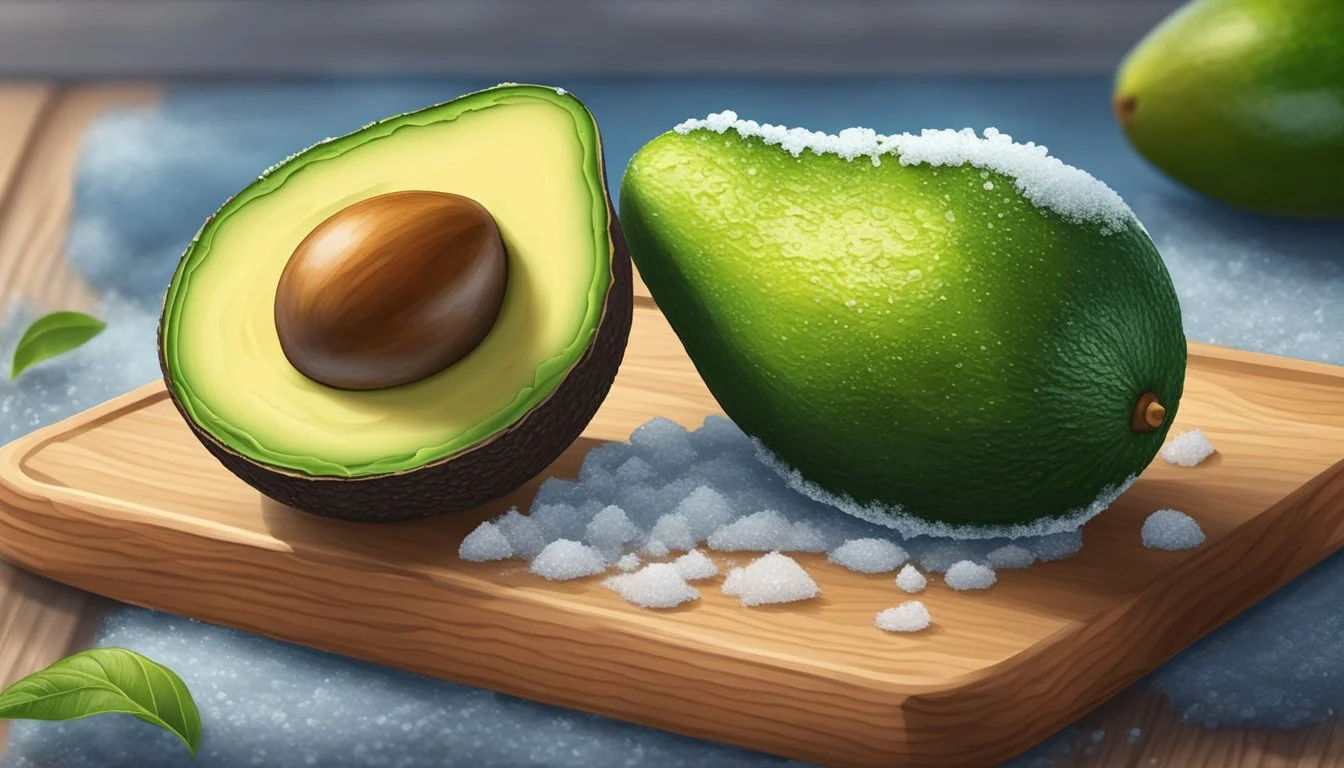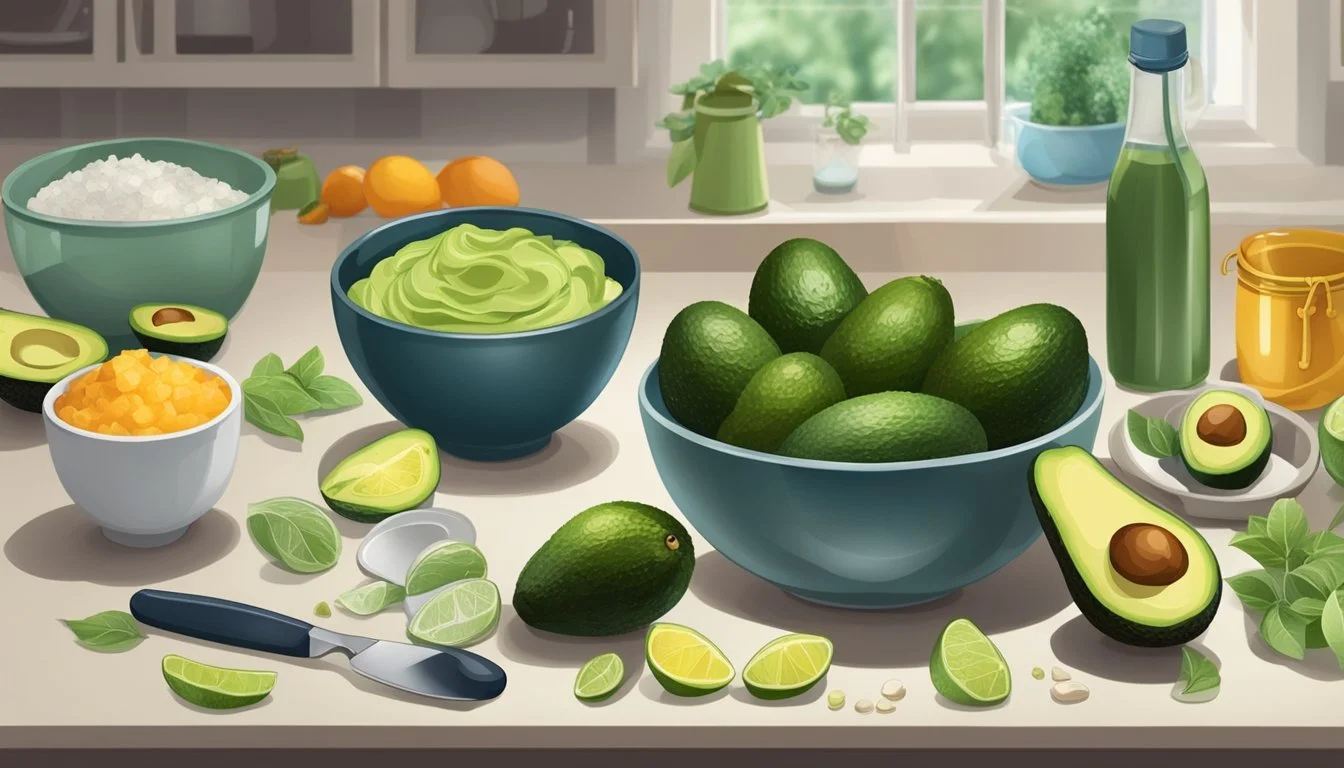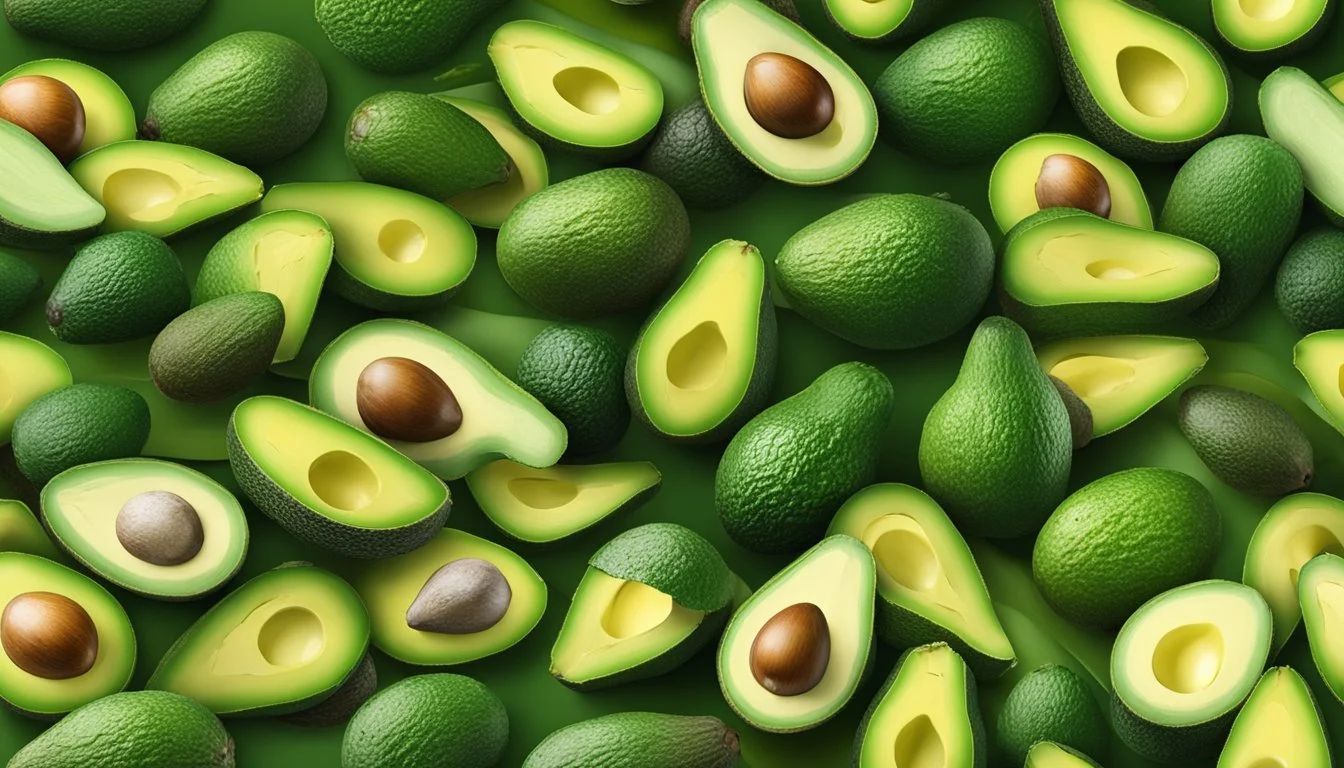Frozen vs Fresh Avocado: Comparing Taste, Texture, and Culinary Uses
Avocado lovers often face a dilemma when their favorite fruit is out of season or unavailable fresh. Frozen avocados have emerged as a potential solution, offering convenience and extended shelf life. One cup of frozen avocado chunks typically equals one whole fresh avocado, making substitution in recipes straightforward.
Frozen avocados can be used in various ways, from smoothies to guacamole. They work particularly well in blended drinks, adding creaminess and healthy fats. For dips and spreads, thawed avocados can be mashed and seasoned just like fresh ones, though the texture may differ slightly.
While frozen avocados offer practicality, they may not match the texture and flavor of fresh fruit in all applications. Slightly frozen avocados can have a different mouthfeel compared to the creamy consistency of ripe, fresh avocados. This difference becomes more noticeable in dishes where avocado is the star ingredient.
Avocados: A Nutritional Overview
Avocados pack a powerful nutritional punch, offering a unique blend of healthy fats, vitamins, and minerals. These creamy fruits are prized for their rich flavor and versatile uses in cuisine.
Health Benefits of Avocado
Avocados are known for their high content of monounsaturated fats, which can help lower bad cholesterol levels. They're an excellent source of fiber, promoting digestive health and aiding in weight management.
The fruit's potassium content surpasses that of bananas, supporting heart health and blood pressure regulation. Avocados also contain antioxidants like lutein and zeaxanthin, which may benefit eye health.
Their healthy fats enhance nutrient absorption from other foods, making avocados a valuable addition to salads and vegetables.
Nutritional Value and Vitamins
A typical avocado half (100g) provides about 160 calories and 14.7g of fat. It contains 2g of protein and 8.5g of carbohydrates, most of which is fiber.
Avocados are rich in:
Vitamin K: essential for blood clotting
Folate: important for cell growth and DNA formation
Vitamin C: an antioxidant supporting immune function
Vitamin B6: aids in metabolism and brain health
Vitamin E: protects cells from oxidative stress
They also offer minerals like magnesium and potassium. The fruit's high fiber content (about 7g per half) aids digestion and promotes feelings of fullness.
Comparing Fresh and Frozen Avocados
Fresh and frozen avocados differ in several key aspects that impact their culinary uses and overall enjoyment. These differences span taste, texture, and appearance, affecting how each type performs in various dishes.
Taste Profiles
Fresh avocados offer a rich, buttery flavor with subtle nutty undertones. Their taste is vibrant and clean, allowing the fruit's natural qualities to shine through. Frozen avocados, while still flavorful, may experience a slight muting of their taste profile.
The freezing process can dull some of the avocado's more delicate flavor notes. However, frozen avocados retain much of their original taste, especially when used in recipes where they're blended or mixed with other ingredients.
In smoothies, frozen avocados perform exceptionally well. They contribute a creamy texture and mild flavor that complements other ingredients without overpowering them.
Texture and Consistency
Fresh avocados are prized for their smooth, creamy texture. When ripe, they spread easily and have a luxurious mouthfeel that's difficult to replicate. Their consistency is ideal for dishes like guacamole or avocado toast.
Frozen avocados, once thawed, may not maintain the same level of creaminess as their fresh counterparts. The freezing process can alter the fruit's cellular structure, leading to a slightly different texture upon defrosting.
For best results, it's recommended to use frozen avocados while still slightly frozen. This helps maintain a firmer texture and prevents excess softening or mushiness.
Color Retention
Fresh avocados have a vibrant green color that's visually appealing in dishes. However, they're prone to browning quickly once cut and exposed to air. This oxidation can affect both appearance and taste if not addressed promptly.
Frozen avocados often retain their color better due to the freezing process. Many frozen avocado products are treated to prevent browning, helping them maintain an appetizing green hue even after thawing.
This color retention makes frozen avocados particularly useful in prepared dishes or when presentation is important. They can provide a consistent green color without the need for additives like lemon juice to prevent browning.
Storage and Preservation
Proper storage techniques can significantly extend the usable life of avocados, whether fresh or frozen. Preventing browning and using effective freezing methods are key to maintaining quality and flavor.
Maximizing Shelf Life
Ripe avocados can be stored in the refrigerator for 3-5 days. Place them in the main compartment, not the crisper drawer, to slow ripening.
For unripe avocados, keep them at room temperature. They'll ripen in 4-5 days. To speed up ripening, place them in a paper bag with a banana or apple.
Check ripeness daily by gently squeezing. When the avocado yields to soft pressure, it's ready to eat or refrigerate.
Preventing Browning
Cut avocados brown quickly due to oxidation. To slow this process, sprinkle lemon or lime juice on exposed flesh. The citric acid acts as a natural preservative.
For guacamole or mashed avocado, add 1/4 teaspoon of ascorbic acid powder per avocado. Mix well to distribute evenly.
Press plastic wrap directly onto the surface of cut avocado or guacamole before refrigerating. This reduces air exposure and slows browning.
Freezing Techniques
Freezing avocados extends their storage time up to 6 months. Choose ripe, unblemished fruit for best results.
Wash and dry the avocados
Cut in half and remove the pit
Peel and mash the flesh
Add 1 tablespoon of lemon juice per avocado
Place in an airtight container or freezer bag
For whole avocado halves, brush with lemon juice and wrap tightly in plastic wrap before freezing. This helps prevent freezer burn.
Thaw frozen avocado in the refrigerator overnight. Use in smoothies, dips, or spreads for best texture.
Usage in Recipes and Meals
Frozen avocados offer versatility in the kitchen, seamlessly integrating into various dishes. They shine in smoothies, guacamole, and salads, providing convenience without sacrificing flavor or nutrition.
Frozen Avocado in Smoothies
Frozen avocado chunks are ideal for creating creamy, nutrient-rich smoothies. They blend easily with other fruits and vegetables, adding a smooth texture and healthy fats. For a basic green smoothie, combine frozen avocado with spinach, banana, and almond milk. Experiment by adding protein powder, chia seeds, or coconut water for extra nutrition and flavor.
Frozen avocados eliminate the need for ice, resulting in a thicker, more satisfying drink. They also help mask the taste of less palatable ingredients like kale or spirulina, making green smoothies more enjoyable.
Creating the Perfect Guacamole
Frozen avocados can be used to make delicious guacamole. Thaw the avocado chunks in the refrigerator or at room temperature. Once softened, mash them with a fork or potato masher. Add finely diced onion, tomato, cilantro, lime juice, and salt to taste.
For extra flavor, incorporate minced garlic or jalapeño peppers. The texture may be slightly different from fresh avocados, but the taste remains comparable. Frozen avocados ensure guacamole can be made year-round, regardless of avocado availability or ripeness issues.
Avocados in Salads and Dressings
Thawed frozen avocados work well in salads and as a base for creamy dressings. For salads, cube the thawed avocado and toss with mixed greens, cherry tomatoes, and a light vinaigrette. They pair nicely with grilled chicken or shrimp for a heartier meal.
To make a simple avocado dressing, blend thawed avocado with lime juice, olive oil, and herbs like cilantro or basil. This versatile dressing works on salads, as a dip for vegetables, or as a spread for sandwiches and wraps.
Frozen avocados can also be incorporated into pasta salads or grain bowls for added creaminess and nutrition.
Practical Tips for Handling Avocado
Proper handling of avocados, whether fresh or frozen, ensures optimal flavor and texture. Mastering thawing techniques and understanding ripeness indicators can elevate your avocado experience.
Thawing Before Use
Frozen avocados require careful thawing for best results. Place frozen avocado chunks on a plate at room temperature for 30 minutes. For quicker thawing, use the microwave in short 15-second bursts, checking frequently to avoid overheating.
Thawed avocados work well in smoothies, adding creaminess and healthy fats. For other uses, serve while still slightly chilled for optimal texture.
Pre-diced frozen avocados offer convenience but may have a softer texture when fully thawed. Use these in recipes where a smooth consistency is desired, like dips or spreads.
Avocado Ripeness and Preparation
Selecting ripe avocados is crucial for fresh preparations. Gently squeeze the fruit - it should yield to pressure but not feel mushy. Remove the stem; if it comes off easily and reveals green underneath, the avocado is ripe.
To ripen avocados faster, place them in a paper bag with a banana or apple. The ethylene gas released will speed up the process.
For slicing or dicing, cut the avocado in half lengthwise around the pit. Twist to separate halves. Remove the pit with a spoon or by carefully tapping a knife into it and twisting. Score the flesh in a grid pattern, then scoop out with a spoon.
To prevent browning, squeeze lemon or lime juice over cut avocado. For storage, wrap tightly in plastic wrap or place in an airtight container with the pit to slow oxidation.
Selecting and Buying Avocado
Choosing the right avocado is crucial for enjoying its flavor and texture. Consider factors like ripeness, intended use, and storage options when making your selection.
Fresh vs Pre-Cut Options
Fresh whole avocados offer the most versatility and control over ripeness. Look for firm avocados if you plan to use them in a few days. Gently squeeze the fruit - it should yield slightly when ripe. Avoid avocados with dark blemishes or soft spots.
Pre-cut options include halved avocados and frozen avocado chunks. These can be convenient but may sacrifice some freshness. Frozen avocado chunks work well in smoothies and some recipes, but their texture differs from fresh avocados when thawed.
Shopping at Supermarkets
Many supermarkets offer a variety of avocado options. Check the produce section for fresh avocados, usually sold individually or in bags. Look for labels indicating origin and variety - Hass avocados are a popular choice known for their creamy texture.
Some stores carry pre-cut avocado halves in the refrigerated section. These have a shorter shelf life but offer immediate use. Frozen avocado chunks can often be found in the freezer aisle. Brands like Dole and store brands like 365 by Whole Foods Market offer these convenient options.
Check "best by" dates on packaged avocados. For loose avocados, ask produce staff about expected ripening times. Some stores may have "ripe now" sections for ready-to-eat avocados.
Innovative Avocado-Based Foods
Avocados have inspired a wave of creative culinary applications beyond traditional uses. Chefs and food innovators are incorporating this versatile fruit into diverse dishes and products, expanding its role in global cuisines.
Avocado Snacks and Breakfast Ideas
Avocado toast remains a popular breakfast choice, with variations like adding poached eggs, smoked salmon, or cherry tomatoes. For snacks, avocado chips offer a healthier alternative to potato chips. These crispy slices are often seasoned with sea salt or spices. Avocado fries, coated in breadcrumbs and baked or air-fried, provide a unique twist on a classic side dish.
Smoothie bowls featuring blended avocado create a creamy base for toppings like granola, fresh berries, and chia seeds. Avocado ice cream has gained traction as a dairy-free dessert option, offering a rich texture and subtle flavor that pairs well with chocolate or lime.
Exploring Global Avocado Dishes
Fusion cuisines have embraced avocados in unexpected ways. Japanese-inspired avocado sushi rolls combine the fruit with rice, nori, and seafood. In Mexico, avocado soup (sopa de aguacate) offers a refreshing cold option for warm days.
Avocado hummus blends Middle Eastern and New World flavors, creating a creamy dip that pairs well with pita or vegetable sticks. Indian-inspired avocado chutney adds a unique twist to traditional accompaniments for curries and breads.
Some chefs incorporate avocados into salad dressings, creating alternatives to Caesar or ranch that boost nutritional value. Avocado-based sauces for pasta dishes provide a creamy texture without dairy, appealing to vegan and lactose-intolerant diners.
The Business of Avocado
The avocado industry has experienced significant growth and transformation in recent years. Market trends and pricing dynamics have shaped the landscape for both fresh and frozen avocado products.
Market Trends for Avocado Products
Avocado consumption has surged globally, driven by health-conscious consumers and culinary trends. Fresh avocados remain the dominant product, but frozen options are gaining traction. Companies like Welch's have introduced pre-cut frozen avocados to meet consumer demand for convenience.
Frozen avocado products offer benefits for foodservice operators. They reduce exposure to price fluctuations and supply disruptions. Frozen avocados are used in various applications, including sandwiches, guacamole, and smoothies.
The popularity of avocado toast and guacamole has fueled growth in both retail and foodservice sectors. Whole Foods Market now offers frozen avocado chunks, catering to the increasing demand for ready-to-use options.
Impact of Avocado Popularity on Prices
Avocado prices have been volatile due to growing demand and supply challenges. Weather conditions, water scarcity, and geopolitical factors affect production in major growing regions.
The price of fresh avocados can fluctuate significantly throughout the year. This volatility has led some businesses to turn to frozen alternatives for more stable pricing.
Increased demand has also driven up land prices in avocado-growing regions. Farmers have expanded production to meet market needs, sometimes at the expense of other crops.
The avocado industry faces sustainability concerns related to water usage and deforestation. These factors may impact future pricing and availability of both fresh and frozen avocados.
Environmental Factors and Avocado Farming
Avocado farming significantly impacts the environment through water usage, deforestation, and carbon emissions. These factors affect both sustainability and crop yields as climate change intensifies.
Sustainability and Farming Practices
Avocado plantations exert substantial pressure on water resources. They consume approximately 9.5 billion liters of water daily, equivalent to 3,800 Olympic-sized pools. This intensive water use can strain local ecosystems and communities.
Deforestation is another major concern. In Mexico, avocado production led to the clearance of 2,900 to 24,700 acres of forests annually from 2010 to 2020. This loss of habitat threatens biodiversity and contributes to climate change.
Fertilizer and fossil fuel use in avocado farming contribute to greenhouse gas emissions. Avocados have a carbon footprint of about 2.5kg CO₂e per kg of fruit, higher than many other fruits.
Sustainable practices are emerging. Some farmers are adopting water-efficient irrigation systems and organic farming methods to reduce environmental impact.
Climate Change and Crop Yield
Climate change poses significant challenges to avocado farming. Rising temperatures and altered precipitation patterns affect crop yields and quality.
Extreme weather events, such as droughts and heatwaves, can damage avocado trees and reduce harvests. These events are becoming more frequent and severe due to climate change.
Shifting climate zones may force farmers to relocate avocado production, potentially leading to further deforestation as new areas are cultivated.
Pests and diseases affecting avocado crops may become more prevalent in warmer conditions, requiring increased pesticide use or risking crop losses.
Researchers are developing more resilient avocado varieties to withstand changing climate conditions. This work aims to maintain crop yields while reducing environmental impact.






